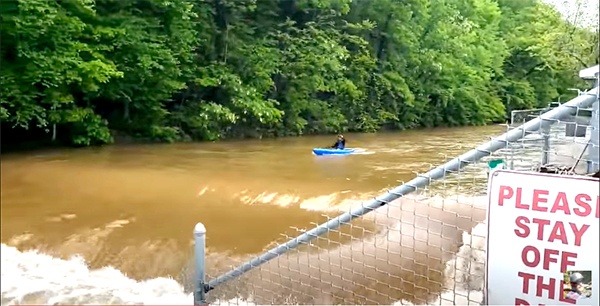Features
Deceptive dangers of low-head dams

By Eng. Thushara Dissanayake
People are fond of recreational activities in rivers such as fishing, bathing and rafting. The country is blessed with a large number of such locations. However, these activities bear a considerable level of risk with an estimated number of 1,100 deaths occurring due to drowning a year. A considerable number of these victims drown in rivers. These mishaps are commonly attributed to flow characteristics, like high velocities, high water depths, turbulence, sudden increase in water levels during rains upstream, etc. On the other hand, it can be due to the presence of structures which create hazardous flow conditions, which many are not aware of. There can be many other contributing factors as regards these deaths. Some of them are alcohol consumption, failure to adopt precautionary measures, such as lifesaving jackets during recreational activities, inability to swim or overestimating ability, reckless behaviour and lack of proper guidance – especially for children.

What is a low-head dam?
Low-head dam is a common structure present in most of our rivers. Technically speaking the height of water mass falling over the dam is low and hence the name. These structures are short, usually less than 15 feet, and span fully across the river section. The amount of water impounded is very small and the main purpose is to raise the water level to divert the flow to elsewhere through canals. In Sri Lanka these low-head dams are commonly identified as water diversion anicuts. As a country rich in irrigated agriculture, Sri Lanka has got a total of many thousands of such anicuts spread across it. In addition, there are similar types of diversion dams constructed for mini hydropower projects and water supply schemes.
Hydraulic behaviour around low-head dams
When the water falls over a low-head dam it generates a recirculating current below the dam and is a deathtrap and nothing can escape it. There are large hydraulic forces and many other hazardous hydraulic conditions occurring but they are not discussed here as the average reader may find them too technical. Suffice it to say that if a person is caught in this recirculating current, he or she will continue to cycle, try as he or she might to escape. Even a boat is not capable of passing this place and often get trapped therein. The water currents below the dam can drag a boat toward the face of the dam and it won’t take a long time for the turbulent water below the dam to swamp it. You may watch a video of a near drowning incident at https://www.youtube.com/watch?v=70kAZMAbdN0 on YouTube to realise the danger. Even well trained rescuers, who are not aware of the behaviour of water and reach the place through water will also get trapped and become victims. Hence, these dams are popularly known as drowning machines. However, it is not fair to say that these structures are always hazardous as much depend on the prevailing flow conditions.
The level of risk varies with the river flow. Consequently, such a location may be safe today but extremely dangerous tomorrow. When the river flow is high the dam is hardly visible as the water level is almost the same below and above the dam. If these locations are closely observed somebody perhaps can see that timber and many debris are tumbling in water below the structures. This is a warning that people should not reach that point.
Mitigating the risks
If disasters are often reported, the structure can be retrofitted to change flow conditions to minimize life threats. Where such structures are newly built the structure can be designed to mitigate the risk, so that access of humans and animals is restricted.
People also have a responsibility to protect themselves against water-related risks. They must properly study a bathing place before getting into it. It is advisable to ask people in the area for more information about the possible risks. Read the warning signs available, wear lifesaving instruments as much as possible and tell someone your plans before getting into the water. All in all, staying at a safe distance away from these places is the best way to avoid danger.
(The writer is a Water Resources Engineer and can be reached at dmtsdissa@yahoo.com)